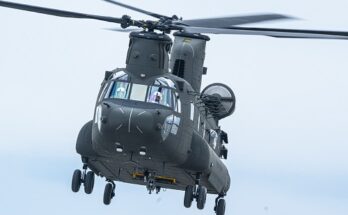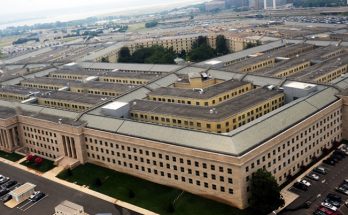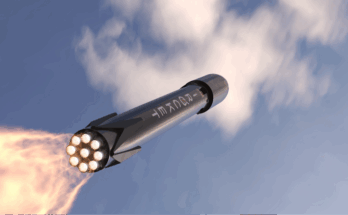
U.S. Defense Secretary Mark Esper outlined plans to build a Navy fleet consisting of over 500 manned and unmanned ships by 2045. The planned fleet features a larger submarine component, a greater number of small surface combatants, and an assortment of manned and optionally manned surface and undersea vessels of all types. Esper argues that this future fleet will be better balanced to address the requirements of great power competition and will support more distributed operations.
The Navy typically releases a 30-year shipbuilding plan alongside its annual budget request, but this year that plan didn’t make it past Esper’s desk. Unconvinced about the affordability and feasibility of the Navy’s long-term shipbuilding plans, Esper called for a broader study of the service’s future force structure. That Future Naval Force Study (FNFS) is now complete, and has informed a new shipbuilding goal dubbed Battle Force 2045. Esper outlined the highlights of Battle Force 2045 in broad strokes during an event hosted by the Center for Strategic and Budgetary Assessments. He said that the Navy will provide Congress with the full FNFS and its new 30-year shipbuilding plan by the end of this year, rather than waiting for the release of the FY22 budget early next year.
The Navy has recently been pursuing a goal of building a fleet of 355 ships, a requirement that stems from a 2016 Force Structure Assessment (FSA). The FY20 long-term shipbuilding plan indicated that the 355-ship goal would not be reached until the mid-2030s. The new Battle Force 2045 plan calls for building up a traditional battle force of 355 ships by 2035, and then growing that force to over 500 ships by 2045. The Navy’s current battle force comprises 296 ships.
According to Esper, the top priority will be to grow the attack submarine fleet to between 70 and 80 subs. The Navy currently operates 50 attack subs, and had a previous goal of reaching 66 subs. This expansion would be accomplished by increasing Virginia class procurement to three per year as soon as possible, and refueling a total of seven Los Angeles class subs. Esper hammered this point home, saying that “if we do nothing else, we should invest in attack submarines.” The Navy’s FY21 budget request only included a single Virginia class sub, but the House Appropriations Committee recommended adding a second boat in its markup. The Senate has yet to take up the bill.
The Navy will continue to rely on a formidable aircraft carrier presence, but the service has not finalized what its carrier force will look like. Esper said the new plan includes between eight and 11 Nimitz and Ford class aircraft carriers, supplemented by up to six light carriers that would possibly be based on the America class amphibious warship. The light carriers would allow for an increased presence overseas, while also freeing up the large carriers for more critical high-end operations.

The Navy currently operates 11 carriers, a threshold that is mandated by law. The uncertainty around the planned number of super carriers certainly needs to be sorted out, as even a single carrier and air wing impacts acquisition and operation & maintenance spending by billions of dollars. The makeup of the carrier force also impacts how the rest of the fleet operates. Congress would have to change the law in order for the Navy to reduce its large carrier fleet, and lawmakers have balked at doing so in the past. The plan to supplement the existing fleet with additional light carriers would alleviate some of the operational risk of reducing the large carrier fleet, but it remains to be seen if that will be enough to assuage the concerns on the Hill. Of course, it is also possible the Navy will leave the large carrier numbers unchanged, at which point the biggest issue becomes the price of sustaining those assets. Esper said he anticipates further study on the appropriate high-low mix for the carrier fleet. He also called for developing unmanned carrier-based aircraft of all types, including fighters, tankers, early warning aircraft, and electronic attack aircraft. The MQ-25A unmanned tanker is already in the works, but it’s clear that the unmanned mission set will be expanded.
Autonomous vessels are expected to make up a sizable portion of the future fleet, with Battle Force 2045 calling for between 140 and 240 unmanned or optionally manned surface and undersea vessels of various types. These vessels would be tasked with missions ranging from missile strikes and minelaying to surveillance and resupply, and would be used both offensively and defensively. Esper highlighted ongoing tests of unmanned surface vessels, but the concept is in its infancy and the Navy is still determining exactly how to integrate unmanned vessels into the fleet. There are also logistics concerns to iron out, such as keeping up with necessary maintenance at sea.

The new force structure plan would see the Navy’s small surface combatant fleet increase to between 60 and 70 ships, compared to 52 ships under the previous plan. This category includes the Littoral Combat Ship and the new frigate class recently awarded to Fincantieri. Similar to the carrier force, the expanded small surface combatant fleet would increase overall capacity while freeing up large surface combatants for more complex missions. The Navy fleet as a whole is weighted toward larger ships like destroyers, while China’s growing Navy has a greater number of smaller frigates, corvettes, and missile boats. Increasing the U.S. small surface combatant force is less costly than buying more destroyers, and also facilitates distributed operations where a destroyer might be overkill.
Esper outlined a desire for 70 to 90 combat logistics ships, but said the service is still studying whether this number is enough to support future combat operations. This figure would include the Medium Logistics Ship that the Marine Corps wants as part of its Force Design 2030 plan, which aims to transform the Marines into a more agile and mobile force. In his speech, Esper expressed support for Force Design 2030, which would also include a new Light Amphibious Warship for the Marines. Ultimately, the amphibious warfare fleet would grow to between 50 and 60 ships, up from the previous requirement of 38 ships. However, Esper said that more work is needed to finalize the amphibious ship requirement.
The large surface combatant fleet was not discussed, but media reports from earlier this year suggested that the new assessment calls for between 80 and 90 large surface combatants, down from the current goal of 104. The Navy already has 91 destroyers and cruisers in the fleet, so Battle Force 2045 could result in destroyer procurement simply keeping pace with older ships being decommissioned. Esper also didn’t specifically discuss command and support ships, which total 39 in the Navy’s original 355-ship requirement. When adding up all of the ship numbers discussed by Esper, the overall fleet size totals somewhere between 529 and 692 ships. Those figures assume a large surface combatant fleet of 80 to 90 ships and 39 command and support ships. The pending 30-year shipbuilding plan should have more concrete numbers. The table below compares the current battle force, the 2016 FSA goal of 355 ships, and the lower and upper limits outlined by Esper as part of Battle Force 2045.
With the new force structure concept on the table, the question turns to whether the plan is realistic or affordable. Esper rightly said that achieving these goals will not be easy in the long run, and that “parochial interests, budget uncertainties, industrial capacity, and other competing factors will contest our ambitions.” The Navy has already been working on ways to free up funding to support its shipbuilding programs, but the reality is that the shipbuilding account will have to be sustained at record levels for this plan to be feasible. In light of the Navy’s recent budgetary efforts, Esper agreed to provide additional funding for shipbuilding from across the DoD, including money from combatant command reviews, fourth estate reforms, and other cost-saving measures. This stance could result in pushback from other services that are fighting for their own piece of the budget, especially with a brand new Space Force whose goal is to bolster funding for space programs.
All of these budgetary reforms made Esper comfortable allocating a larger piece of the Navy budget for shipbuilding moving forward. Esper said that 13 percent of the Navy’s total budget will support shipbuilding programs, matching the average percentage spending for new ships during the Reagan buildup in the 1980s. The Navy’s annual budget averaged around $209 billion (adjusted FY21 dollars) while Reagan was in office, which is on par with the $207 billion requested by the service in FY21. The latest request set aside $19.9 billion for shipbuilding, or around 9.6 percent of the total, which was notably much lower than originally planned. The shipbuilding account accounted for 11.4 percent of the Navy’s FY20 budget and 10.6 percent of the FY19 budget. A 13 percent allocation for ships in FY21 would have totaled $27 billion.
The Navy’s latest five-year spending plan calls for average annual spending of $215.5 billion in current dollars, or $206.4 billion in constant FY21 dollars. Esper’s rough 13 percent estimate would result in annual shipbuilding budgets averaging around $28 billion per year in current dollars, or $26.8 billion in constant FY21 dollars. For comparison, the shipbuilding account has averaged $18.1 billion since 2010 (not adjusted for inflation), and the FY21 five-year spending plan called for an average of $23.7 billion per year for shipbuilding. The Navy’s outyear projections are based on a DoD budget that has zero real growth over the next five years after adjusting for inflation. A flat budget is generally viewed as a best-case scenario, and the fiscal and economic ramifications of the pandemic could result in defense cuts that would make it even harder to free up funding for the larger fleet plans.
Esper also wants more support from Congress in making sure that budgets are timely, predictable, and sustained. The past decade has been a budgetary mess in that regard, with Budget Control Act spending limits resulting in years of continuing resolutions, late budgets, and unpredictable spending patterns. BCA spending limits expire in FY21, which will at least eliminate one bureaucratic obstacle. He also wants congressional support for divesting legacy equipment in order to prioritize new programs. Lawmakers are often resistant to retiring legacy systems that still have some operational life left, and it will be harder for the Navy to free up funding if that trend continues.

The defense secretary is also seeking new budget authorities for the Navy that would allow the service to transfer any unobligated funding remaining at the end of the year to the shipbuilding account, rather than letting it expire. This move would require congressional approval, but it remains to be seen if lawmakers will embrace the concept. If they do, it could come with a host of limitations to prevent any new budget authorities from turning into loopholes that could be abused, such as how the Pentagon’s Overseas Contingency Operations account became a slush fund for all sorts of priorities.
Potentially making matters worse, the Congressional Budget Office has repeatedly warned that the Navy underestimates the long-term costs of its shipbuilding programs. In an October 2019 analysis of the Navy’s FY20 shipbuilding plan, the CBO estimated that long-term costs would average $31 billion per year (2019 dollars), compared to the Navy’s $24.1 billion estimate. Much of the discrepancy boiled down to uncertainty about future ship designs, particularly the future large surface combatant and future attack submarines. The CBO also argued that the Navy hasn’t adequately accounted for higher inflation rates for labor and materials in the shipbuilding industry. If CBO estimates are correct, then the Navy will face an even greater challenge in funding its ambitious fleet expansion plans. The Navy has also run into problems controlling costs in the past, with, for example, the Ford class aircraft carrier, Littoral Combat Ship, and DDG 1000 destroyer becoming far more expensive than originally planned. The learning curve with nascent autonomous technologies also introduces cost risk, particularly in the area of long-term maintenance.
Regardless of whether the Navy is able to build the fleet to the size that it wants, Battle Force 2045 at least provides a view of how future acquisition decisions will be guided. The initial focus will be on submarine procurement, trying to bolster small surface combatant numbers, and continuing to develop unmanned capabilities. At the same time, logistics and maintenance are critical priorities, particularly as the service works to pull itself out of a maintenance backlog. Esper noted that officials must be cognizant of an excess demand for naval forces and the subsequent strain placed on maintenance infrastructure and budgets. Bolstering ship numbers could reduce the operational strain placed on individual ships, but the upkeep of a larger force presents new challenges of its own.
Shaun's deep-rooted interest in military equipment continues in his role as a senior defense analyst with a focus on the United States. He played an integral role in the development of Forecast International's U.S. Defense Budget Forecast, an interactive online product that tracks Pentagon acquisition programs throughout the congressional budget process. As editor of International Military Markets – North America, Shaun has cultivated a deep understanding of the vast defense markets in the United States and Canada. He is a regular contributor to Forecast International's Defense & Security Monitor blog and has co-authored white papers on global defense spending and various military programs.





